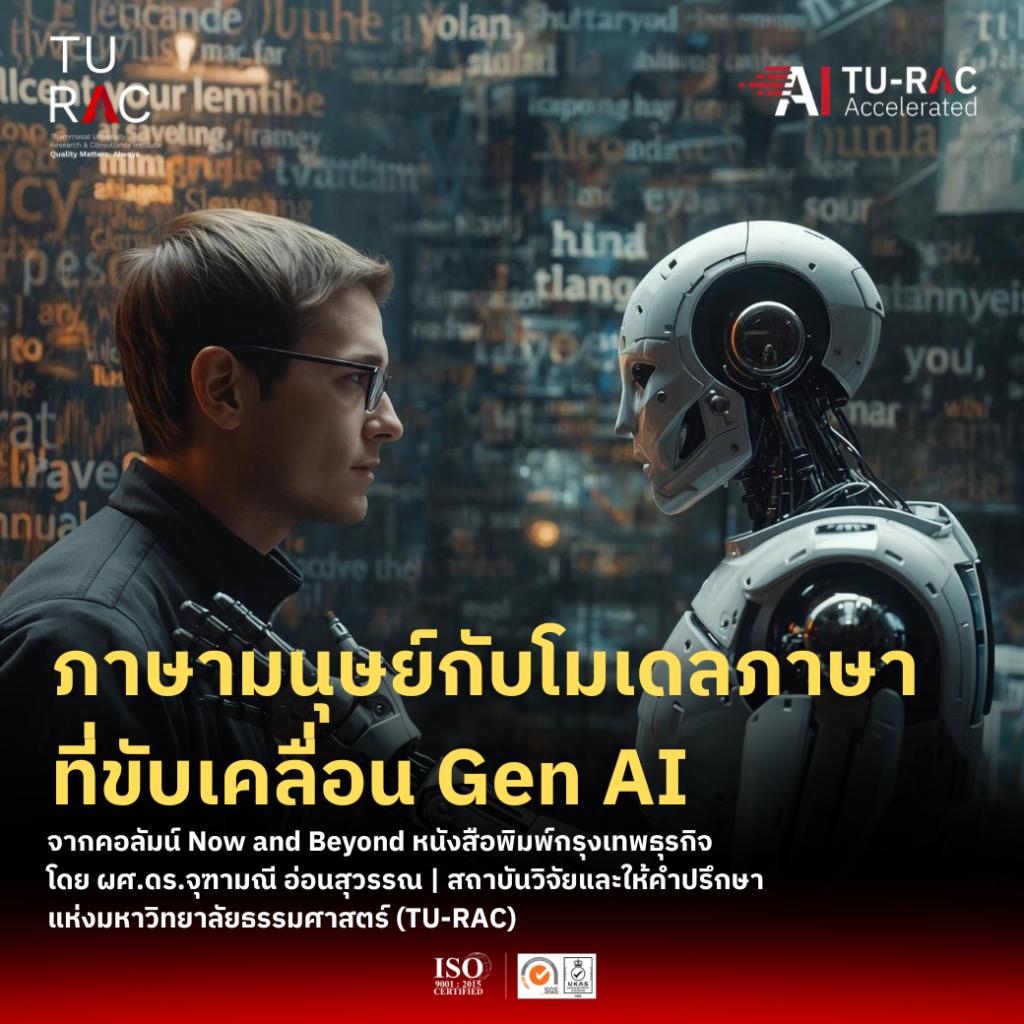TU-RAC ชวนอ่านบทความจากกรุงเทพธุรกิจ ในคอลัมน์ Now and Beyond by TU-RAC ทุกวันพฤหัสบดี ในหนังสือพิมพ์กรุงเทพธุรกิจ และกรุงเทพธุรกิจออนไลน์ เรื่อง ภาษามนุษย์กับโมเดลภาษาที่ขับเคลื่อน Gen AI โดย ผศ. ดร.จุฑามณี อ่อนสุวรรณ สถาบันวิจัยและให้คำปรึกษาแห่งมหาวิทยาลัยธรรมศาสตร์ (TU-RAC)
.
ความก้าวหน้าของ ปัญญาประดิษฐ์เชิงสร้างสรรค์ (Gen AI) โดยเฉพาะ โมเดลภาษาขนาดใหญ่ (LLMs) เช่น ChatGPT และ Gemini ซึ่งสามารถประมวลผลและสร้างภาษามนุษย์ได้จากการฝึกฝนด้วยข้อมูลจำนวนมหาศาล อย่างไรก็ตาม ความแตกต่างที่สำคัญระหว่างการทำงานของ LLMs กับกลไกการเรียนรู้ภาษาและการรู้คิดของมนุษย์ เพราะภาษามนุษย์มีความซับซ้อนมากกว่าแค่ข้อความเขียน รวมถึงข้อจำกัดของข้อมูลที่ใช้ในการฝึกฝน LLMs ซึ่งส่วนใหญ่เป็นข้อความจากอินเทอร์เน็ตที่จำกัด และแตกต่างจากการเรียนรู้ภาษาของเด็กเล็กที่ได้รับข้อมูลหลากหลายรูปแบบ ดังนั้น LLMs จึงเป็นเพียงเครื่องมือ ไม่ใช่ทฤษฎีการรู้คิดหรือทฤษฎีทางภาษา และผู้ใช้ควรใช้วิจารณญาณในการใช้งาน แม้ว่าทั้ง LLMs และมนุษย์จะสามารถเรียนรู้จากข้อมูลที่จำกัดได้ แต่กระบวนการเรียนรู้ก็มีความแตกต่างกันอย่างมีนัยสำคัญ
.
? อ่านบทความฉบับเต็มได้ที่: https://www.bangkokbiznews.com/tech/gadget/1197832
How deeply can AI truly “understand” language?
.
TU-RAC invites you to read an article from Bangkok Biz News in the column Now and Beyond by TU-RAC, published every Thursday in both the Bangkok Biz newspaper and online. The featured article, “Human Language and Language Models Driving Gen AI”, is written by Asst.Prof.Dr.Chutamanee Onsuwan, Thammasat University Research and Consultancy Institute (TU-RAC).
.
The advancement of Generative AI (Gen AI), particularly large language models (LLMs) such as ChatGPT and Gemini, has enabled machines to process and generate human language through training on massive datasets. However, there are significant differences between how LLMs operate and how humans acquire and understand language. Human language encompasses far more than just written text, while LLMs are primarily trained on limited text-based data, often sourced from the internet. This is very different from how young children acquire language, which involves diverse and multimodal input.
Therefore, LLMs should be seen merely as tools—not as cognitive or linguistic theories in themselves. Users must exercise critical judgment when applying them. While both LLMs and humans can learn from limited data, the underlying learning processes are fundamentally different.
.
? Read the full article here: https://www.bangkokbiznews.com/tech/gadget/1197832



